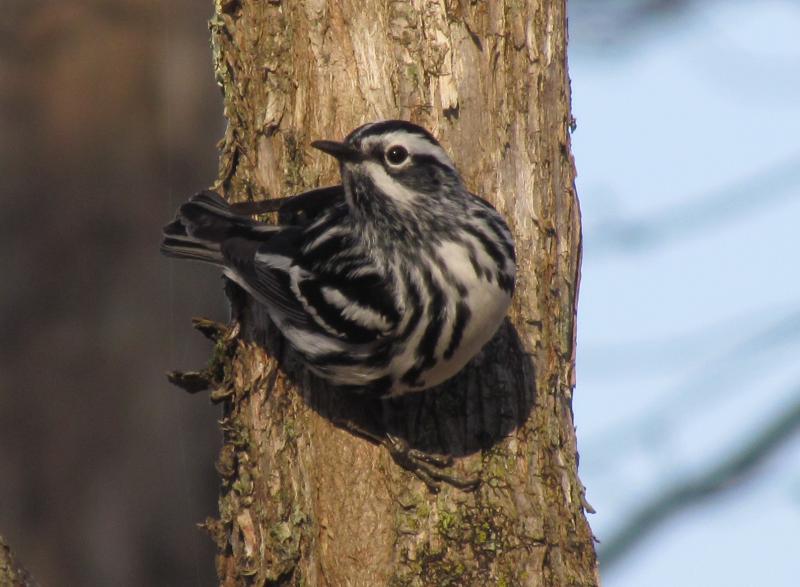
It may come as an unwelcome surprise to learn that as many as 40-60% of the small songbirds that you see and hear around your yard, garden, field, and forest will not survive from one year to the next. And for young birds just out of the nest, the numbers don’t get any better.
It’s probably pretty easy to understand why. Just yesterday, on one of our neighborhood dog walks, we saw two parent song sparrows chipping in alarm as they tried to lure a too-close cat away from where we presume their young were hiding in the grass. Another day we saw a just-out-of-the-nest young robin that barely got out of the road ahead of what would have been a lethal collision with a car.
When you consider the incredible difficulties birds face in migration and, for those that stay farther north, the extremes of cold and bad weather they experience each winter, survival of any of them seems almost like a miracle. A recent study that compared the number of migrant birds detected on weather radars across the U.S. from one year to the next showed that about a third fewer birds returned in spring as traveled south in the fall. Another study, a long-term one of the black-throated blue warbler (Maine supports a high proportion of the global population of this species), showed that 85% of the mortality occurred during migration.
For small birds like warblers in our part of the world, the results of the travails of their wild bird lives means that adults may expect to live only a few years. That is not to say that occasional, very lucky or skilled individuals may make it past the age of five or rarely even as old as nine or ten years.
On the opposite end of the spectrum are many of the seabirds. The world’s oldest known wild bird is a female Laysan albatross that was banded in 1956. She was still alive and nesting in 2021 at the estimated minimum age of 70 years of age! Here in Maine, seabirds like herring and great black-backed gulls, and Arctic and common terns, and Atlantic puffins can live for decades.
In between these extremes are birds like blue jays and American crows whose maximum life spans can be 10-15+ years, and barn and tree swallows that may occasionally live up to 8-12 years.
An interesting thing to consider is that birds that live very short lives or whose eggs or young are highly likely to be taken by predators or lost in some other way, tend to lay more eggs than long-lived species. They often also may have more than one clutch each breeding season. Many warblers lay four to five eggs in each nesting attempt. They may successfully raise two broods per season, and if they lose their eggs and/or young early enough in the season they will keep trying to renest. Some will try up to five times in a single season! Also, warblers usually reach breeding age in their first year. If they didn’t, they might not have a chance to reproduce given the fairly high likelihood that they might not survive to the next year.
Seabirds like the gulls and terns, on the other hand, can take four or five years or more to reach breeding age, and they usually only lay two or three eggs. Atlantic puffins also usually don’t start breeding until four or five years of age but lay only a single egg each season. Over their long lifetime, they will have multiple chances to raise an offspring that makes it into the breeding population and carries on the lineage that propels all birds—all living things—forward.
Jeffrey V. Wells, Ph.D., is a Fellow of the Cornell Lab of Ornithology and Vice President of Boreal Conservation for National Audubon. Dr. Wells is one of the nation's leading bird experts and conservation biologists and author of the “Birder’s Conservation Handbook.” His grandfather, the late John Chase, was a columnist for the Boothbay Register for many years. Allison Childs Wells, formerly of the Cornell Lab of Ornithology, is a senior director at the Natural Resources Council of Maine, a nonprofit membership organization working statewide to protect the nature of Maine. Both are widely published natural history writers and are the authors of the popular books, “Maine’s Favorite Birds” (Tilbury House) and “Birds of Aruba, Bonaire, and Curaçao: A Site and Field Guide,” (Cornell University Press).
"bird" - Google News
June 30, 2021 at 09:15PM
https://ift.tt/35ZuBX0
How Long Do Birds Live? - Boothbay Register
"bird" - Google News
https://ift.tt/2s1zYEq
https://ift.tt/3dbExxU
Bagikan Berita Ini















0 Response to "How Long Do Birds Live? - Boothbay Register"
Post a Comment